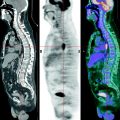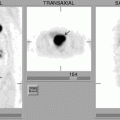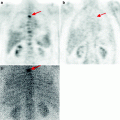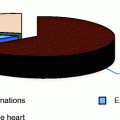, Leonid Tiutin2 and Thomas Schwarz3
(1)
Russian Research Center for Radiology and Surgery, St. Petersburg, Russia
(2)
Department of Radiology and Nuclear Medicine, Russian Research Center for Radiology, St. Petersburg, Russia
(3)
Department of Nuclear Medicine Division of Radiology, Medical University Graz, Graz, Austria
Abstract
Stomach cancer (SC) is one of the most frequent forms of malignant tumors of the gastrointestinal tract. About one million persons develop SC annually in the world. In the Russian Federation SC is the third most common among all oncological diseases, after lung cancer and skin cancer. It is most often older people (50–60 years old) who develop SC. Up to 25% of registered SC cases fall in the age range of 40–50 years (Merabishvili 2006). The etiology of this disease still remains unknown. However, the results of experimental studies and data of epidemiological research have revealed some predisposing factors as well as precancerous states. Among predisposing factors leading to SC, there are: diet with excess of common salt provoking osmotic lesion of epithelium and facilitating contamination of mucous membrane with Helicobacter pylori bacteria, smoking, regular use of alcohol and hereditary susceptibility to carcinogenic influence. The main precancerous diseases are chronic gastritis, stomach polyposis and chronic ulcer (Gantsev 2004).
Stomach cancer (SC) is one of the most frequent forms of malignant tumors of the gastrointestinal tract. About one million persons develop SC annually in the world. In the Russian Federation SC is the third most common among all oncological diseases, after lung cancer and skin cancer. It is most often older people (50–60 years old) who develop SC. Up to 25% of registered SC cases fall in the age range of 40–50 years (Merabishvili 2006). The etiology of this disease still remains unknown. However, the results of experimental studies and data of epidemiological research have revealed some predisposing factors as well as precancerous states. Among predisposing factors leading to SC, there are: diet with excess of common salt provoking osmotic lesion of epithelium and facilitating contamination of mucous membrane with Helicobacter pylori bacteria, smoking, regular use of alcohol and hereditary susceptibility to carcinogenic influence. The main precancerous diseases are chronic gastritis, stomach polyposis and chronic ulcer (Gantsev 2004).
At the beginning of development of SC, clinical symptoms are extremely diverse and marked pathognomonic signs are absent. Disease manifestations are usually limited to generalized symptoms: weakness, lower ability to work, lowering or loss of appetite, gastric discomfort, progressing apparently causeless weight loss. Late symptoms entirely depend on the anatomic situation of the tumor, form of the mass and its rate of growth and metastasis. In cancer of the antral section, for example, a sense of repletion, bitter eructation, and vomiting just after having eaten food are characteristic. As the tumor grows, these symptoms increase too. Cancer of the cardiac part does not manifest itself for a long time and occurrences of dysphagia appear only as the stomach entry narrows and the tumor process expands to the oesophagus. In cancer of the body of the stomach, weakness, anemia, lowering of appetite and depression come to the foreground. Stenosis occurrences and marked painful sensations appear in case of significant tumor dissemination when the tumor expands to the antral or cardiac sections of the stomach. Long asymptomatic course is also characteristic of cancer of the fundus of the stomach. Clinical manifestations appear only when the diaphragm and pleura are affected by tumor (Vazhenin et al. 2003; Shalimov et al. 2000).
7.1 Pathological Anatomy and Mechanisms of Metastases
The classification put forward by Bormann in 1926 has received the widest use for morphological characteristics of SC. It distinguishes four anatomical types of SC:
Type 1 – polypoid and fungoid circumscribed cancer with exophytic growth.
Type 2 – cup-shaped and saucer-shaped cancer with clearly contoured boundaries and cylinder-like raised edges, which is considered as destructive form of polypoid cancer.
Type 3 – ulcerous-infiltrative, ulcerating or ulcer-like cancer, whose tissue is not clearly delimited from the surrounding stomach wall.
Type 4 – diffuse cancer characterized by the thickening of the entire stomach wall; a marked form of endophytic fibrous cancer (scirrhus) is linitis plastica. In this stage of tumor, the stomach has the shape of a thick-walled tube from the pylorus to the cardiac orifice.
The histological structure of SC is characterized by large diversity, which has given rise to numerous classifications. In order to unify the data, the international WHO classification was drawn up in 1977 and is still used. It distinguishes non-differentiated cancer, signet ring cell carcinoma of the stomach, mucous adenocarcinoma (colloid cancer), glandular-planocellular cancer, planocellular cancer, and unclassified tumors. It should be noted that this classification does not have any prognostic significance.
Metastases in SC occurs in three ways: lymphogenous, hematogenous and by implantation (dissemination through peritoneum). Most often, dissemination takes place in the form of different combinations of the indicated ways, lymphogenous metastasis being principal.
Presently it is considered that metastatic changes in lymph nodes appear in the following sequence:
1.
Lesion of regional lymph nodes situated in the gastric ligaments
2.
Infiltration of lymph nodes accompanying big arteries
3.
Secondary lesion of retroperitoneal lymph nodes and organs of the abdominal cavity
SC metastasizes via the hematogenous route to the liver, lungs, adrenal glands, bones and hypodermic cellular tissue. Implantation metastases are formed during contact transfer of tumor cells through the peritoneum in the form of small military eruptions – carcinomatosis. Krukenberg metastases (to the ovary), Virchow’s metastasis (to the left supraclavicular lymph nodes), Sister Mary Joseph’s nodule (to the navel) are also examples of secondary implantation changes; in the advanced stages of cancer, metastatic lesion of pararectal cellular tissue of the fundus of the small pelvis (Schnitzler metastasis) may occur.
7.2 Methods of Diagnosis
Radiological examination is one of the classic methods of detecting SC but it’s importance decreased over the last decades according to the rise of CT, US and Gastroscopy. Among the most important radiological symptoms there are: filling defect, loss of elasticity, tensility of the stomach wall leading to the absence of peristalsis of the stomach in the area of tumor lesion, change in the stomach landscape in the site of the malignant formation.
However, all the mentioned symptoms are typical of the late stages of SC when tumorous lesion has a disseminated character. Meanwhile, detecting and differentially diagnosing the initial forms of SC based on the radiological examination of the stomach is still a difficult, sometimes unsolvable task. This is due to the fact that at the onset of the disease tumor process is limited to the mucous membrane and does not expand to the submucous layer; it is in the form of flat erosion, defined as a low-intensity spot with unclear contours.
Fibrogastroscopy (FGS) is today the leading examination method when SC is suspected; it permits determination of the character of tumor growth and localization, as well as to obtain material for performing cytological or morphological examinations. The main advantage of the method over radiological examination is the possibility to detect early forms of SC in 90% of cases. At the same time, complex examination of the stomach (both radiological and gastroscopic) increases the diagnostic accuracy up to 96.7%.
Stay updated, free articles. Join our Telegram channel

Full access? Get Clinical Tree








